History
The assembly of the bourgeois and citizens of Geneva constituted the General Council. The number of bourgeois entitled to vote in the General Council never exceeded fifteen hundred. The General Council originally elected the Geneva Trustees, magistrates responsible for the administration of the commune, for a period of one year. Later, it appointed the Council of Two Hundred. Most citizens of Geneva came from neighboring Savoy because many of them worked and participated in the administration of the city of Geneva. [6]
Revolts against nepotism and the influx of foreigners, particularly French Protestant refugees whom Calvin forced into the bourgeoisie to ensure his domination. He thus secured a majority in the elections of 1554. During the eighteenth century, Geneva was marked by many political troubles stemming from the inequality of rights between Genevois. The bourgeois, who enjoyed a privileged status, and their descendants, the citizens, held the upper hand: had all the political rights and many economic privileges. In front of them, the inhabitants and their descendants, the natives, form a population without political rights and hampered in its economic activities. [2] Due to the French invasion of Switzerland, the bourgeoisie of Geneva lost their privilege in 1798. All Genevans have been ordinary citizens since that date.
The capacity of Bourgeois, that is to say of citizen of a city having political rights not available to other residents, forms the base of the urban organization of cities. This urban system in Europe for many cities dates back to Greco-Latin antiquity, [7] others were founded around the year 1000. According to Pierre Bonenfant, this system of urban civilization developed in parallel to the rural civilization rooted in the Neolithic era. [8]
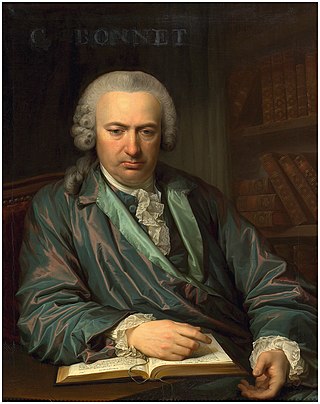
Charles Bonnet was a Genevan naturalist and philosophical writer. He is responsible for coining the term phyllotaxis to describe the arrangement of leaves on a plant. He was among the first to notice parthenogenetic reproduction in aphids and established that insects respired through their spiracles. He was among the first to use the term "evolution" in a biological context. Deaf from an early age, he also suffered from failing eyesight and had to make use of assistants in later life to help in his research.
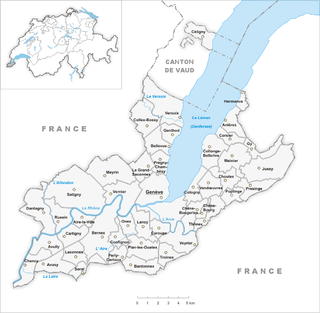
The Canton of Geneva, officially the Republic and Canton of Geneva, is one of the 26 cantons of the Swiss Confederation. It is composed of forty-five municipalities, and the seat of the government and parliament is in the City of Geneva.

Jacques Mallet du Pan was a Genevan political journalist and propagandist. A Calvinist thinker and Counter-Revolutionary reformer, he opposed extreme positions held by both Revolutionary and Counter-Revolutionary partisans during the French Revolution.
The Walloon Movement is an umbrella term for all Belgium political movements that either assert the existence of a Walloon identity and of Wallonia and/or defend French culture and language within Belgium, either within the framework of the 1830 Deal or either defending the linguistic rights of French-speakers. The movement began as a defence of the primacy of French but later gained political and socio-economic objectives. In French, the terms wallingantisme and wallingants are also used to describe, sometimes pejoratively, the movement and its activists. To a lesser extent, the Walloon Movement is also associated with the representation of the small German-speaking population in the East Belgium of the Walloon Region.
The Walloon Movement traces its ancestry to 1856 when literary and folkloric movements based around the Society of Walloon language and literature began forming. Despite the formation of the Society of Walloon Literature, it was not until around 1880 that a "Walloon and French-speaking defense movement" appeared, following the linguistic laws of the 1870s. The movement asserted the existence of Wallonia and a Walloon identity while maintaining the defense of the French language.

Jean-Marie Klinkenberg is a Belgian linguist and semiotician, professor at the State University of Liège, born in Verviers (Belgium) in 1944. Member of the interdisciplinary Groupe µ. President of the International Association for visual Semiotics.

The Socialists and affiliated group is a parliamentary group in the National Assembly of France that includes representatives of the Socialist Party (PS).

The Seven Noble Houses of Brussels were the seven families or clans whose descendants formed the patrician class and urban aristocracy of Brussels, Belgium.

The Geneva Citizens' Movement, abbreviated to MCG, is a right-wing populist political party in the Canton of Geneva, Switzerland. On its own initiative, it started, and is a part of, the wider Romandy Citizens' Movement, abbreviated to MCR.

Antoine-Jacques Roustan was a Genevan pastor and theologian, who engaged in an extensive correspondence with Jean-Jacques Rousseau. Unlike Rousseau, he believed that a Christian republic was practical - that the Christian religion was not incompatible with patriotism or republicanism.
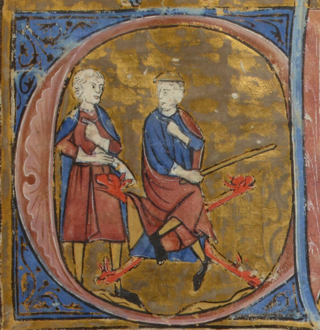
Guillaume le Vinier (c. 1190–1245) was a cleric and trouvère, one of the most prolific composers in the genre. He has left compositions in all the major subgenres of trouvère poetry: chansons d'amour, jeux-partis, a lai, a descort, a chanson de mal mariée and a ballade. He wrote Marian songs and even an imaginary dialogue with a nightingale. His work can be dated with some precision: the poem "En tous tens" is quoted in the Roman de la violette, which was written around 1225.
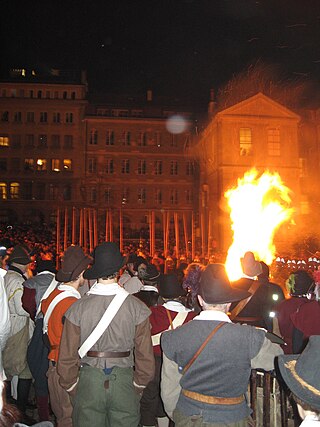
The Compagnie de 1602 is an historic and patriotic association in Geneva who organize the official commemoration of the Escalade. This association was established on March 31, 1926.
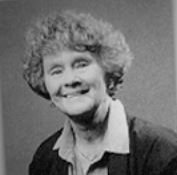
Claire Bonenfant was a Canadian politician and champion of feminist rights. A Chevalier of the Ordre national du Québec, Bonenfant was president of the Quebec Status of Women Council. The University of Laval's "Claire Bonenfant Chair in Women's Studies" is named in her honour.
Auxbrebis, originally also written as A Brebis when recognized as échevins (Alderman) and Patrician thereafter as aux Brebis, is an old noble family name. The name has been attested as early as in the thirteenth century. They are illustrated as originating from the city of Dinant as merchants and copper beaters.

Emma Kammacher was a Swiss human rights lawyer, activist and politician. She was a member of the Social Democratic Party of Switzerland and served as a member of the Grand Council of Geneva. In 1965 she became the first woman to serve as president of a Swiss cantonal council.

Charles Bonnet is a Swiss archeologist, specialist of Ancient Nubia.
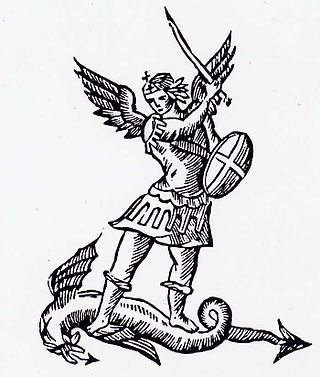
In Brussels, as in most European cities, one needed the capacity of bourgeois in order to not only exercise political rights, but also to practice a trade, which, in Brussels, meant to be a member of the Guilds or of the Seven Noble Houses. The charter of Brussels, as codified in 1570 in articles 206 and following, provided the conditions of admission to the bourgeoisie of the city. The Bourgeois were the patrician class of the city. This social class was abolished by Napoleon during the French occupation.

A bourgeois of Paris was traditionally a member of one of the corporations or guilds that existed under the Ancien Régime. According to Article 173 of the Custom of Paris, a bourgeois had to possess a domicile in Paris as a tenant or owner for at least a year and a day. This qualification was also required for public offices such as provost of the merchants, alderman or consul, but unlike the bourgeois or citizens of other free cities, Parisians did not need letters of bourgeoisie to prove their status.
Jean-François Poron was a French actor and director.















